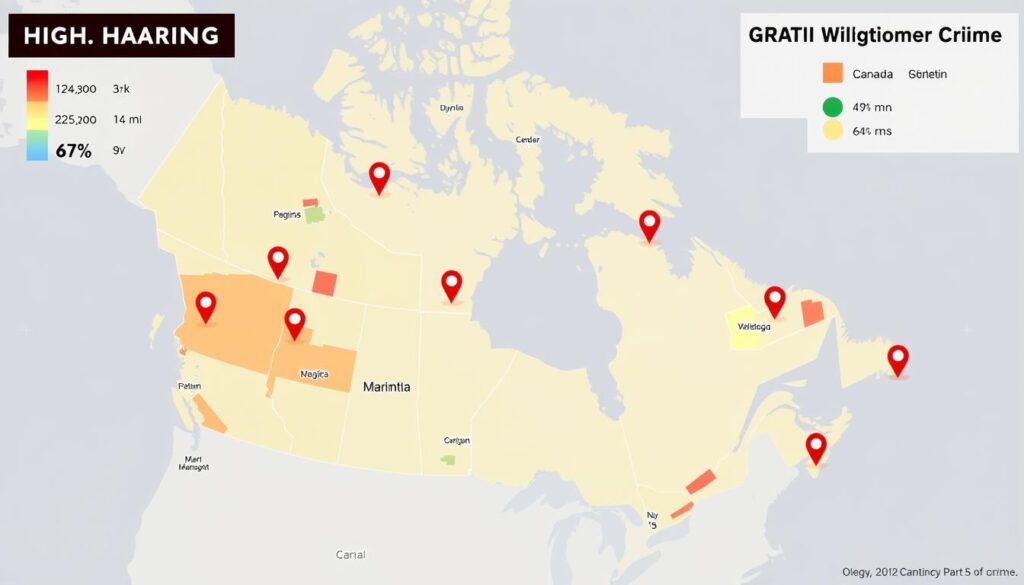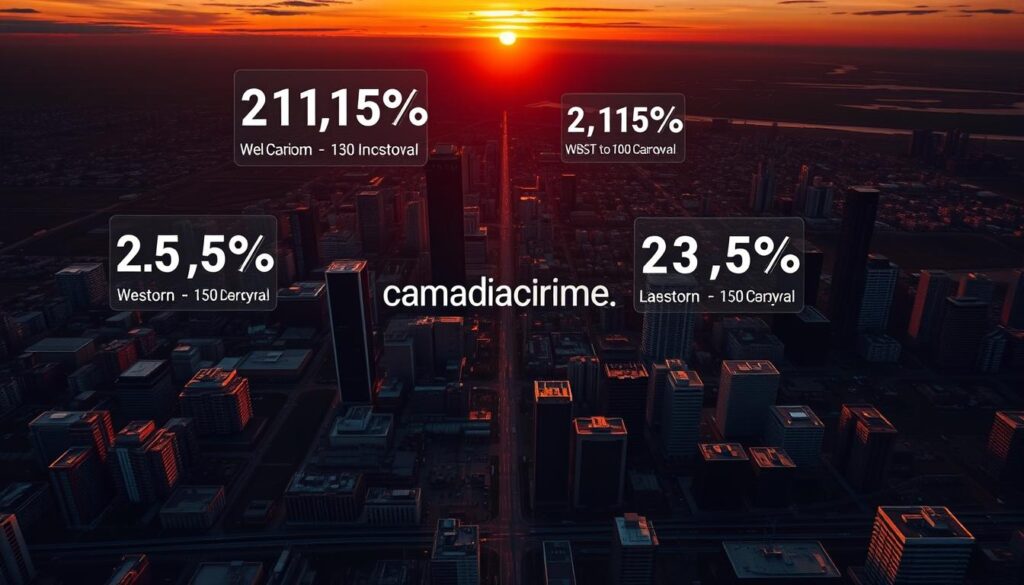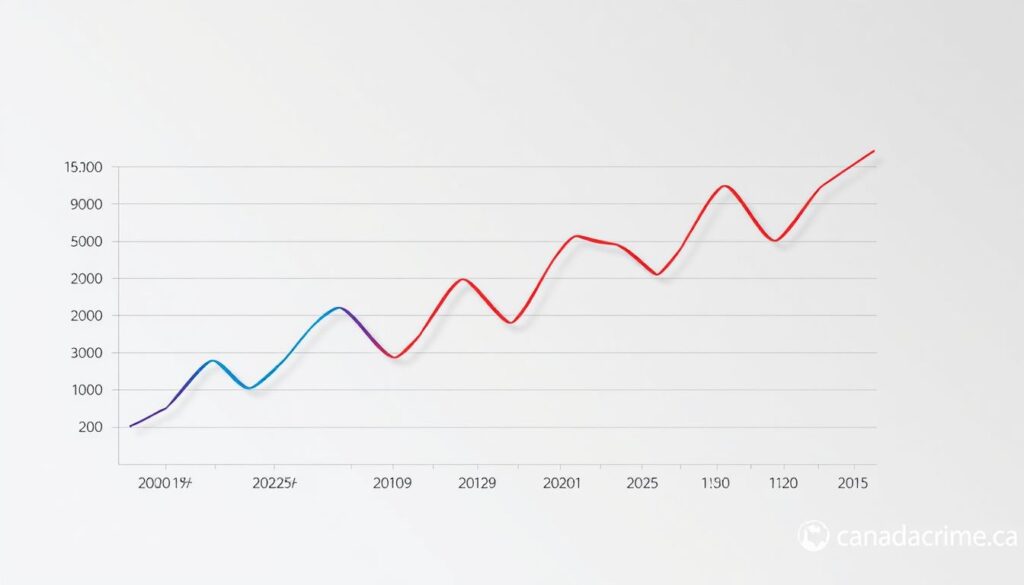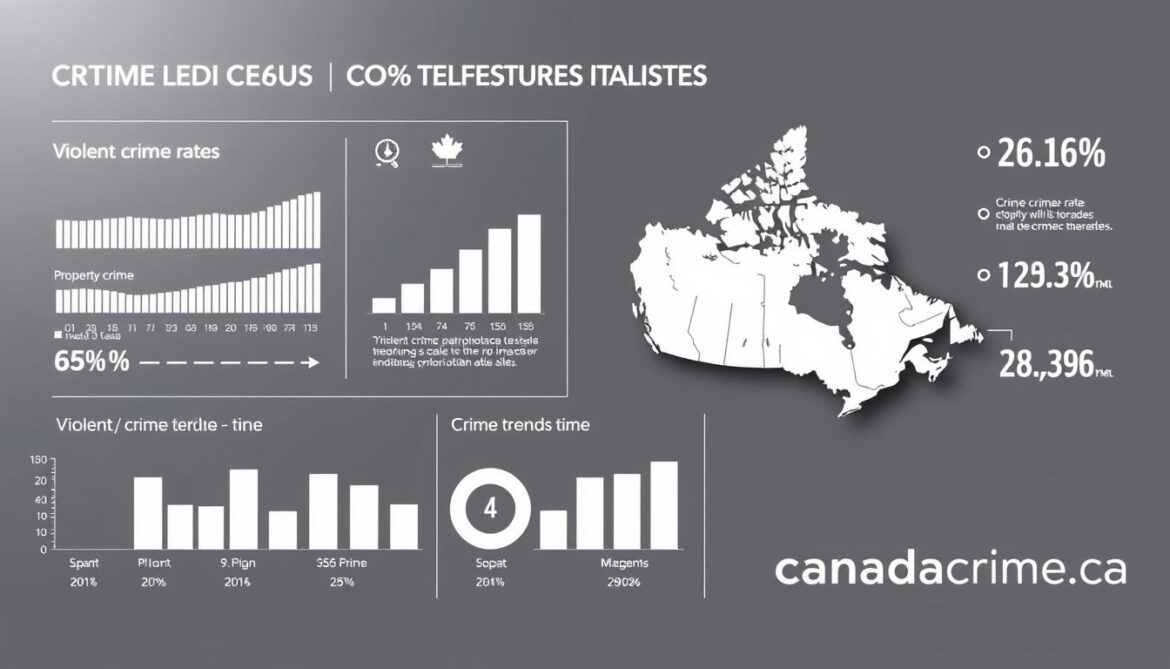Canada is often regarded as a safe haven, but like any other country, it faces its share of crime challenges. Recent statistics reveal that certain cities in Canada experience higher crime rates due to various factors, including socioeconomic conditions and the effectiveness of local law enforcement.
The Crime Severity Index (CSI) is a crucial metric used to measure and compare crime across different municipalities in Canada. By analyzing the most recent data and statistics, we can identify the cities facing the most significant challenges with both violent and property crime.
This comprehensive guide will delve into the crime information and data from authoritative sources, providing insights into the factors contributing to crime in these areas and the measures being taken to enhance safety and reduce crime rates.
Understanding Crime Measurement in Canada
To grasp the scope of crime in Canada, it’s essential to understand the methodologies used to measure and report criminal incidents. Crime rates are measured using several key indicators, providing a comprehensive view of the crime landscape.

Crime Severity Index Explained
The Crime Severity Index (CSI) is a critical metric that accounts for both the volume and seriousness of crimes. By assigning weights to different types of crimes based on their severity, the CSI offers a nuanced understanding of crime trends. For instance, violent crimes are given more weight than property crimes, reflecting their greater impact on society.
As noted by a recent report, “The Crime Severity Index is a valuable tool for understanding the complexity of crime in Canada, as it captures both the frequency and severity of criminal incidents.” This approach allows for a more accurate comparison of crime rates across different regions.
How Crime Statistics Are Collected
Crime statistics in Canada are primarily collected through the Uniform Crime Reporting (UCR) Survey, which standardizes how police services across the country report criminal incidents. The data collection process involves detailed documentation of each reported crime, including the nature of the offense, location, time, and demographic information about both victims and offenders when available.
- Police services across all provinces and territories submit their crime data to Statistics Canada.
- Statistics Canada compiles, analyzes, and publishes comprehensive reports on crime trends throughout the country.
- Beyond police-reported incidents, Statistics Canada also conducts the General Social Survey on Victimization.
Understanding the methodologies behind crime data collection helps contextualize statistics about high-crime cities and explains why certain communities may appear more dangerous in official reports than others.
Factors Contributing to High Crime Rates in Canadian Cities
Several key factors contribute to the high crime rates observed in various Canadian cities. Understanding these factors is essential for developing effective strategies to mitigate crime and improve public safety.
Socioeconomic Conditions
Socioeconomic conditions play a significant role in determining crime rates. Factors such as poverty, unemployment, and lack of access to education can contribute to higher crime rates. Cities with significant socioeconomic disparities often experience higher rates of crime, as individuals may turn to criminal activities as a means of survival or to address perceived injustices. Economic inequality can exacerbate feelings of frustration and hopelessness, potentially leading to increased criminal behavior.
Population Density and Urban Issues
Population density and urban issues are also critical factors. Densely populated urban areas often face challenges related to overcrowding, poor housing conditions, and inadequate community resources. These conditions can contribute to higher crime rates as they may foster environments conducive to criminal activity. Moreover, urban areas with insufficient lighting, poor surveillance, and lack of community engagement can become hotspots for crime.

Law Enforcement Effectiveness
The effectiveness of law enforcement is a crucial factor in determining crime rates across Canadian cities. Variations in policing strategies and resources significantly impact crime outcomes. Cities with understaffed police departments or those lacking specialized units to address specific crime types often struggle to maintain adequate crime prevention and response capabilities. The relationship between police and community members is also vital, with cities fostering strong police-community partnerships typically experiencing more successful crime reduction.
- Law enforcement effectiveness is influenced by factors beyond officer numbers, including training quality, technological resources, and departmental policies.
- In some high-crime Canadian cities, challenges with police recruitment, retention, and funding create situations where law enforcement struggles to keep pace with criminal activity.
- Effective law enforcement strategies, including community policing and intelligence-led policing, can significantly reduce crime rates by addressing the root causes of criminal behavior.
By understanding these factors and their interplay, Canadian cities can develop targeted interventions to reduce crime rates and improve public safety.
The Highest Crime Rate Cities in Canada for 2025
Canada is home to diverse cities, some of which are grappling with higher crime rates, making it essential to examine the data for 2025.

The crime rate in Canada varies significantly across different cities, with some experiencing higher rates of violent and property crimes. Understanding these trends is crucial for both residents and policymakers.
Top 5 Most Dangerous Cities
The top 5 most dangerous cities in Canada for 2025 are characterized by their high crime indices, reflecting challenges such as violent crimes, property crimes, and other safety concerns.
- Hamilton, Ontario: With a crime index of 55.8, Hamilton faces challenges in addressing break-ins and vehicle theft.
- Brampton, Ontario: Brampton’s crime index stands at 55.3, driven by rapid population growth and urban expansion, leading to increases in both violent and property crimes.
- Kamloops, British Columbia: Kamloops sees a rising crime index at 54.8, with ongoing struggles with drug-related offenses and property crimes.
Other cities in the top 5 include those with similar challenges, where crime rates are influenced by socioeconomic factors and law enforcement effectiveness.
Rising Crime Hotspots
Beyond the top 5, several Canadian cities are experiencing concerning upward trends in their crime rates.
- London, Ontario: London’s crime index has climbed to 53.9, with growing concerns about property and drug-related crimes.
These cities often share common characteristics, including rapid demographic changes and economic challenges, which complicate crime prevention efforts.
Crime Profile: Western Canadian Cities
The Prairie Provinces and British Columbia are facing notable crime issues, affecting the safety and security of residents. Western Canada’s crime landscape is characterized by varying rates of violent and property crimes across different cities.

British Columbia’s Crime Challenges
British Columbia experiences a unique set of crime challenges. While it has some of the safest cities in Canada, certain areas struggle with higher crime rates. The province has seen fluctuations in crime rates over the years, influenced by factors such as socioeconomic conditions and law enforcement strategies.
Key crime trends in British Columbia include:
- Varied crime rates across different regions, with some urban areas experiencing higher rates of violent crime.
- The impact of socioeconomic factors on crime, including poverty and lack of access to education and employment opportunities.
- Efforts by law enforcement to address crime through community policing and targeted initiatives.
Prairie Provinces Crime Landscape
The Prairie Provinces, including Manitoba, Saskatchewan, and Alberta, face significant crime challenges. Cities like Winnipeg, Regina, and Saskatoon consistently rank among Canada’s most dangerous. Winnipeg, Manitoba’s capital, has a Crime Severity Index (CSI) of 118.5, with a notable disparity between violent and non-violent crime. The city saw a 20% jump in crime severity from 2021 to 2022, the largest increase among major Canadian cities.
The crime landscape in the Prairie Provinces is marked by:
- High violent crime rates, with Regina having the third-highest violent crime CSI nationally.
- Socioeconomic factors contributing to elevated crime rates, including higher rates of poverty and unemployment.
- Disproportionate impacts of crime on Indigenous communities, reflecting broader social inequities.
The crime situation in Western Canadian cities underscores the need for comprehensive approaches to address the root causes of crime and improve public safety.
Crime Profile: Eastern Canadian Cities
A closer look at Eastern Canadian cities reveals a complex picture of crime and safety, with some areas standing out as particularly secure. The region’s diverse urban centers exhibit a range of crime rates, influenced by various socioeconomic and law enforcement factors.
Ontario’s Urban Crime Centers
Ontario, home to Canada’s most populous city, Toronto, showcases a varied crime landscape. While Toronto has a relatively moderate crime rate, other cities in Ontario experience different levels of violent crime. For instance, some urban areas face challenges related to gang violence and property crime, contributing to a higher crime rate compared to more suburban or rural areas.
The effectiveness of law enforcement and community programs plays a crucial role in shaping the crime profile of Ontario’s cities. Cities with proactive policing strategies and community engagement tend to have lower crime rates, highlighting the importance of safety initiatives.
Quebec and Atlantic Provinces
Quebec and the Atlantic Provinces generally maintain lower crime rates compared to Western Canada. Quebec City, for example, boasts a remarkably low crime index of 22.2 and a high safety index of 77.8, making it one of Canada’s safest urban centers. Similarly, Montreal has a crime index of 32.8, demonstrating that large urban populations don’t necessarily correlate with high crime rates.
The Atlantic Provinces, including New Brunswick, Nova Scotia, Prince Edward Island, and Newfoundland and Labrador, typically experience lower crime rates than the national average. However, certain communities face localized challenges. For instance, Halifax, Nova Scotia’s capital, has a crime index of 41.0, placing it in the middle range of Canadian cities.

The relatively lower crime rates in Quebec and Atlantic Canada are often attributed to stronger social cohesion, different approaches to social services, and demographic factors that differ from high-crime regions. These regional differences highlight how crime patterns vary significantly across Canada’s diverse geography, influenced by local economic conditions, cultural factors, and governance approaches.
Understanding the Canadian Crime Code
The Canadian Criminal Code serves as the backbone of Canada’s criminal law, detailing a wide range of crimes and their legal implications. It is a comprehensive legal framework that has evolved over time to address emerging issues and societal changes.
Key Criminal Code Sections
The Canadian Criminal Code encompasses various sections that define different crimes and outline the legal processes for handling them. Key sections include those related to violent crimes, such as assault and homicide, as well as property crimes like theft and vandalism.
Law enforcement agencies rely on the Criminal Code to investigate and prosecute crimes effectively. For instance, sections dealing with impaired driving have been strengthened to combat this significant public safety concern.
Recent Legislative Changes
Recent years have seen significant updates to the Canadian Criminal Code, reflecting evolving crime patterns and changing social attitudes. Bill C-75, implemented in 2019, introduced substantial changes aimed at reducing court delays and addressing the overrepresentation of vulnerable populations in the criminal justice system.
- Reforms to bail provisions have impacted how repeat offenders are handled, with new considerations for victim and public safety.
- Legislative changes regarding impaired driving have strengthened law enforcement’s ability to address alcohol and drug-impaired driving.
- Updates to laws concerning sexual assault have clarified consent definitions and improved protections for victims.
These legislative changes directly impact how crimes are investigated, prosecuted, and sentenced in Canada’s highest-crime cities, influencing both crime rates and public perceptions of safety.
| Legislative Change | Impact on Crime Handling |
|---|---|
| Bill C-75 | Reduced court delays and addressed overrepresentation of vulnerable populations |
| Reforms to Bail Provisions | New considerations for victim and public safety in pretrial detention decisions |
| Impaired Driving Laws | Strengthened law enforcement ability to address alcohol and drug-impaired driving |

Types of Crimes Prevalent in High-Risk Areas
High-crime areas in Canada are characterized by a diverse range of criminal activities, necessitating a closer examination of the types of crimes prevalent in these regions. The complexity of crime in these areas demands a nuanced understanding of both violent and non-violent offenses.
Violent Crimes Analysis
Violent crimes, including assaults and other offenses that cause harm or threat to individuals, are a significant concern in high-risk areas. According to crime statistics, violent crimes are more prevalent in areas with socioeconomic challenges and higher population densities. For instance, a report by the Department of Justice Canada highlights the correlation between socioeconomic factors and violent crime rates. The impact of violent crimes extends beyond the immediate victims, affecting community cohesion and overall safety.
Moreover, violent crimes can have long-lasting effects on victims and their families, making it crucial for law enforcement and community initiatives to address these crimes effectively.
Property and Non-Violent Crimes
Property crimes, such as theft, break-ins, and vehicle theft, are among the most common types of crimes in high-risk Canadian cities. These crimes not only result in financial losses but also contribute to a sense of insecurity among residents. For example, cities like Kelowna and Vancouver have struggled with high rates of residential burglaries, which can have profound psychological impacts on victims.
Non-violent crimes, including fraud, cybercrime, and drug trafficking, also pose significant challenges. The rise of organized retail crime and sophisticated scams targeting vulnerable populations has led to substantial economic impacts in affected areas. 
Addressing these crimes requires a multifaceted approach that involves law enforcement, community engagement, and legislative measures to prevent and mitigate the effects of both violent and non-violent crimes.
Crime Trends and Statistics: 2020-2025
Analyzing crime trends and statistics from 2020 to 2025 reveals a complex picture of crime rates in Canada. This period has seen various fluctuations, with some cities experiencing significant improvements while others face persistent challenges.

Impact of the Pandemic on Crime Rates
The COVID-19 pandemic has had a notable impact on crime rates across Canada. According to recent data, many cities have seen decreases in violent crime rates. For instance, preliminary data for early 2024 indicates a 15.2% reduction in violent crimes nationwide compared to the same period in 2023. Specific types of crimes have shown even more significant declines; for example, murder rates fell by 26.4%, and assault incidents decreased by 12.5%.
Year-over-Year Crime Rate Changes
Year-over-year crime rate changes from 2020 through 2025 reveal complex patterns across Canadian cities. The national trend shows an overall decrease in violent crime rates since 2023. Cities like Quebec City and Ottawa have maintained consistently low crime rates throughout this period, while others like Surrey and Winnipeg continue to struggle. Statistical analysis reveals that crime rate changes often vary significantly between neighborhoods within the same city, highlighting the localized nature of crime challenges.
These trends and statistics provide valuable insights for policymakers and law enforcement, helping identify both successful crime reduction strategies and persistent problem areas requiring additional resources.
Canada’s Safest Cities: A Comparison
Canada’s safest cities offer a compelling narrative of security and community, where residents enjoy a high quality of life with minimal exposure to crime. These urban centers have implemented various strategies to maintain low crime rates, making them attractive to both residents and businesses.

What Makes These Cities Safe
The top five safest cities in Canada for 2025 are Quebec City, Oakville, Burlington, Ottawa, and Montreal. These cities have demonstrated exceptional safety through their low crime indices and high safety indices. Quebec City, for instance, boasts a crime index of 22.2 and a safety index of 77.8, setting a national benchmark for urban safety.
Several factors contribute to the safety of these cities. Effective law enforcement, community engagement, and socioeconomic conditions all play a role in maintaining low crime rates. For more information on Canada’s crime landscape, visit Canada Crime Rates.
Safety Indices and Rankings
Safety indices provide a standardized metric for comparing security levels across Canadian cities. The inverse relationship between crime and safety indices offers a comprehensive view of urban safety conditions. The rankings of the safest cities are as follows:
- Quebec City: Crime Index – 22.2, Safety Index – 77.8
- Oakville: Crime Index – 26.1, Safety Index – 73.9
- Burlington: Crime Index – 29.7, Safety Index – 70.3
- Ottawa: Crime Index – 31.3, Safety Index – 68.7
- Montreal: Crime Index – 32.8, Safety Index – 67.2
These rankings help residents, businesses, and policymakers make informed decisions about where to live, invest, and implement successful safety strategies.
Preventing Crime in Canadian Communities
Preventing crime in Canadian communities requires a multi-faceted approach that involves both community-based initiatives and individual safety measures. Effective crime prevention strategies are crucial for maintaining safe and secure environments for residents.
Community-Based Initiatives
Community-based initiatives play a vital role in preventing crime across Canada. These programs focus on building stronger, more cohesive communities where residents look out for one another. Neighborhood watch programs, community policing initiatives, and youth mentorship programs are examples of successful community-based initiatives. By fostering a sense of community and cooperation, these programs can significantly reduce crime rates.
Moreover, community-based initiatives often involve collaboration between local law enforcement, community organizations, and residents. This collaborative approach ensures that crime prevention strategies are tailored to the specific needs and challenges of each community. For instance, some communities may focus on addressing socioeconomic factors that contribute to crime, such as poverty and lack of opportunities.
Individual Safety Measures
Individual safety measures are equally important in preventing crime. Residents can take several steps to enhance their personal safety and security. Developing a comprehensive safety plan is essential, which includes knowing safe routes to common destinations, having emergency contacts readily available, and staying informed about local crime trends.
- Improving home security through proper lighting, secure locks, and visible security systems can deter property crimes.
- Practicing personal safety habits, such as being aware of surroundings and avoiding isolated areas at night, can reduce the risk of street crimes.
- Implementing digital security measures, including password protection and being cautious of scams, can prevent cybercrime.
- Building connections with neighbors can create informal surveillance networks that enhance community safety.
Educational resources provided by local police services and community organizations can help residents develop effective personal safety strategies. By combining community-based initiatives with individual safety measures, Canadian communities can create a robust crime prevention framework.
| Prevention Strategy | Description | Impact |
|---|---|---|
| Community-Based Initiatives | Programs that foster community cohesion and cooperation | Reduces crime through community engagement |
| Individual Safety Measures | Personal safety practices and home security improvements | Enhances personal and property security |
| Digital Security | Measures to protect against cybercrime | Prevents identity theft and financial fraud |

Conclusion
As Canada continues to evolve, understanding its crime landscape is crucial for creating safer communities. The 2025 crime index reveals that while cities like Surrey and Kelowna face rising crime rates, others like Quebec City and Oakville maintain low rates, setting benchmarks for safety. Effective crime prevention requires comprehensive strategies that address both immediate concerns and underlying causes, combining law enforcement efforts with community engagement. By understanding these dynamics, Canadian cities can work toward creating safer environments for all residents.

